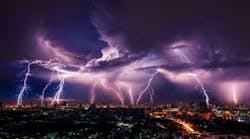Storm-assessment services make the difference in utility outage-restoration efforts
By Hari Vasudevan, Think Power Solutions founder and CEO
Natural disasters are some of the worst-case scenarios for utilities. And in the United States, each year, we get our fair share of weather. 2020 is the sixth consecutive year in which 10 or more billion-dollar weather and climate disaster events have impacted the United States.
These tornados, as well as thunderstorms, hurricanes and ice storms all wreak massive damage on utility transmission lines, substations and distribution lines.
Storm-assessment services provide resources that are at the ready and easily mobilized to conduct damage evaluations and restoration efforts with experienced personnel equipped with real time reporting technology tools. Technology combined with these critical services get electric utilities back to pre-storm functionality quickly and completely. Contract storm-assessment services enable a utility to better utilize their internal experienced resources for more critical, immediate restoration efforts.
Storm-assessment services can engage with utilities in a number of ways. All utilities have some version of a formal storm plan; written processes and procedures with personnel identified for specific roles during a major event. The need for storm-assessment services is outlined in these plans with criteria pertaining to when to use internal resources versus using external resources. In some events, such as a hurricane, advance notice is available in planning for assessments and restoration timeline. In many cases, a partnership with an external assistance service is already established, with guidelines and requirements identified, ensuring there is no lost time during initial deployment.
Assessment begins with an initial damage investigation, where a qualified inspection team visits an assigned area and identifies the location and extent of damage to the utility infrastructure. This initial assessment also helps the utility make informed decisions on the number of additional resources required, such as wire watchers to be deployed to guard wires that are damaged and potentially hazardous to the public, or vegetation crews that are needed to clear areas before the overhead utilities can be repaired.
Depending upon the nature and extent of damage, a secondary, deeper investigation may follow where more detailed information is collected about the damaged sectors of the utility. A utility map is often utilized to chart out the scene with information detailing known hazards within the work area. Maps will generally be created to show access points, a listing of affected roadways, transmission and distribution lines, and initial notations of any structural damage. Drone footage may also be employed for help in evaluating the damage as a whole. Preliminary-damage assessments allow the affected utility to determine what types of additional resources are needed to restore service safely and effectively for their customers.
Depending on the type of infrastructure affected, a preliminary assessment may be followed by a more detailed damage assessment. These detailed assessments might include in-depth foundation, hardware, equipment and structure damage evaluations. Detailed damage assessments can provide material lists, identify special equipment needs, and determine site-accessibility concerns. Restoration assessments detail material-cost estimates regarding restoration materials such as mats, construction entrances, pipeline crossings, culverts and gates. Vegetation concerns and restoration-level inspections are also considered and undertaken during the construction phase.
Qualified material coordinators (or scouts) with in-depth human performance training and a focus on health and safety provide a key role in expediting restoration efforts. Human performance is a work process that analyzes how actions can result in mistakes and how remediating behaviors can reduce or eliminate those errors. Human-performance principles help an individual maintain positive control of a work situation, ensuring that what is intended to happen is all that happens.
A two-person team consisting of a driver and an assessor has the advantage of being able to safely patrol while driving. When the assessor leaves the vehicle to inspect a storm damaged site, the driver assumes the duty of maintaining contact with the person on foot both by visual and verbal communication. The driver also has the duty to pinpoint the assessor’s location in the event of an emergency. The recruitment of seasoned and experienced team members ensures safe, accurate and thorough assessments.
Often, storm-assessment services include proprietary software products that address the process of collecting and interpreting data. The software uses information technology and artificial intelligence (AI) to optimize storm-outage investigations, damage evaluation as well as repair and restoration efforts.
Construction oversight and inspections are also a crucial part of restoring a utility back to its pre-storm function. These final, post-assessments can provide details of “lost lights outs” by making final determinations about the last-to-be-restored streetlights that are missing or not working. Information technology in the field is used in various ways at this point, including as an interface with client software. For instance, the assessment team can easily share photos with restoration crews and document the data surrounding material and debris cleanup requirements.
Storm-assessment services can make the difference between an extended utility outage and one that is remediated quickly and efficiently. By utilizing software products that streamline the process of collecting and interpreting data, utilities get real-time information from the field, and are able to make informed restoration decisions. Using information technology and AI in tandem with trained personnel helps optimize the repair and restoration process.
With a mindset of doing what is necessary to bring users back online for their health and safety, technology-enabled storm assessment services provide a lifeline for utilities hard hit by the forces of Mother Nature.



